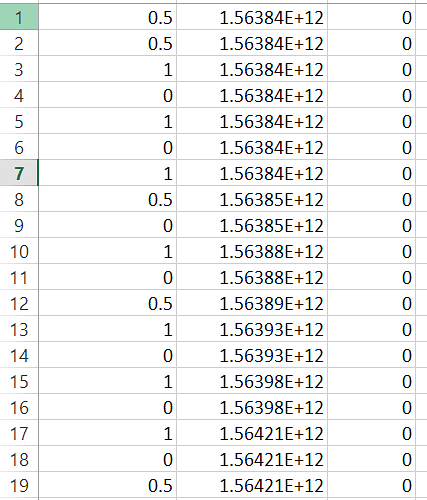Hello,
I’m using an esp8266 to control my garage. Everything works, except for data collection. What I am trying to do is to write a “0” or “1” to virtual pin 3 whenever my garage opens or closes, detected by an ultrasonic sensor. However, when I look at the pin history, I get values that seem to come out of nowhere. The only possible values should be 0 or 1, as the only code involving v3 is virtualWrite(3, 0) and virtualWrite(3, 1)
screenshot of csv file (values are col A, timestamp col B, not sure what col C is for:
Using Blynk cloud server on version 0.6.1
#include <ESP8266WiFi.h>
#include <BlynkSimpleEsp8266.h>
// You should get Auth Token in the Blynk App.
// Go to the Project Settings (nut icon).
char auth[] = "";
// Your WiFi credentials.
// Set password to "" for open networks.
char ssid[] = "";
char pass[] = "";
const static double MILLIS_TO_INCH = .0067515;
const int trigPin = 0;
const int echoPin = 4;
boolean isGarageOpen = false;
unsigned long time_of_last_garage_cycle = 0;
//cycle through 1 rest, 2 clear trig, 3 write trig pin, and 4 wait for echo to measure sensor
unsigned long current_interval = 0; //used for all different states of ultrasonic sensor
unsigned long timer_start_time = 0;
const static int REST_TIME = 1000000; //how often to measure distance
boolean isResting = true; //ultrasonic sensor not active
const static int CLEAR_TIME = 2;
boolean isClearingTrigPin = false;
const static int WRITE_TIME = 10;
boolean isWritingTrigPin = false;
const static int TIMEOUT = 20000; //if ultrasonic sensor takes longer than 20 ms
//to return value assume distance is large enough for garage to be open
//boolean isAwaitingEcho = false; //commented because not using interrupts to measure ultrasonic
boolean text_sent = false; //ensure notification of garage open >30 min only sent once
//int time1 = 0; //start and
//int time2 = 0; //end time for measuring ultrasonic
//void ICACHE_RAM_ATTR echoFall ();
//void ICACHE_RAM_ATTR echoRise ();
void setup()
{
digitalWrite(5, HIGH);
// Debug console
// Serial.begin(9600);
Blynk.begin(auth, ssid, pass);
pinMode(trigPin, OUTPUT); // Sets the trigPin as an Output
pinMode(echoPin, INPUT);
// pinMode(echoPin, INPUT_PULLUP);
// attachInterrupt(digitalPinToInterrupt(echoPin), echoFall, FALLING);
// attachInterrupt(digitalPinToInterrupt(echoPin), echoRise, RISING);
current_interval = REST_TIME; //schedule first ultrasonic sensor measurement
timer_start_time = micros();
// You can also specify server:
//Blynk.begin(auth, ssid, pass, "blynk-cloud.com", 80);
//Blynk.begin(auth, ssid, pass, IPAddress(192,168,1,100), 8080);
}
void loop()
{
updateUltrasonic();
Blynk.run();
// You can inject your own code or combine it with other sketches.
// Check other examples on how to communicate with Blynk. Remember
// to avoid delay() function!
}
void updateUltrasonic() {
unsigned long t = micros() - timer_start_time;
if (t >= current_interval) {
if (isResting) {
isClearingTrigPin = true;
isResting = false;
digitalWrite(trigPin, LOW);
timer_start_time = micros();
current_interval = CLEAR_TIME;
}
else if (isClearingTrigPin) {
isClearingTrigPin = false;
isWritingTrigPin = true;
digitalWrite(trigPin, HIGH);
timer_start_time = micros();
current_interval = WRITE_TIME;
}
else if (isWritingTrigPin) {
isWritingTrigPin = false;
digitalWrite(trigPin, LOW);
// isAwaitingEcho = true;
// time_of_next_event = millis() + TIMEOUT;
unsigned long measuredDist = pulseIn(echoPin, HIGH);
measuredDist = measuredDist * MILLIS_TO_INCH;
// Serial.println(measuredDist);
boolean state;
String msg;
if (measuredDist > 16) {
state = false;
msg = "Closed ";
}
else {
state = true;
msg = "Opened ";
}
if (state != isGarageOpen) { //garage changed state aka cycled
time_of_last_garage_cycle = millis();
isGarageOpen = state;
Blynk.virtualWrite(1, isGarageOpen);
if (isGarageOpen) {
Blynk.virtualWrite(1, "Garage is open");
Blynk.virtualWrite(3, 1);
}
else {
Blynk.virtualWrite(1, "Garage is closed");
Blynk.virtualWrite(3, 0);
text_sent = false; //reset email notif
}
}
msg += formatMillis(millis() - time_of_last_garage_cycle) + " ago";
Blynk.virtualWrite(2, msg); //time since last cycle
if (isGarageOpen && !text_sent && millis() - time_of_last_garage_cycle >= 1800000) {
Blynk.notify("your garage has been open for over 30 minutes");
text_sent = true;
}
// isAwaitingEcho = false;
isResting = true;
timer_start_time = micros();
current_interval = REST_TIME;
}
// else if (isAwaitingEcho) { //reached only if timeout occurs
// Serial.println("timeout");
// echoFall();
// }
}
}
String formatMillis(unsigned long m) {
m = m / 1000;
int hours = m / 3600;
m = m % 3600;
int minutes = m / 60;
int seconds = m % 60;
return String(hours) + " hr, " + String(minutes) + " min, " + String(seconds) + " sec";
}
